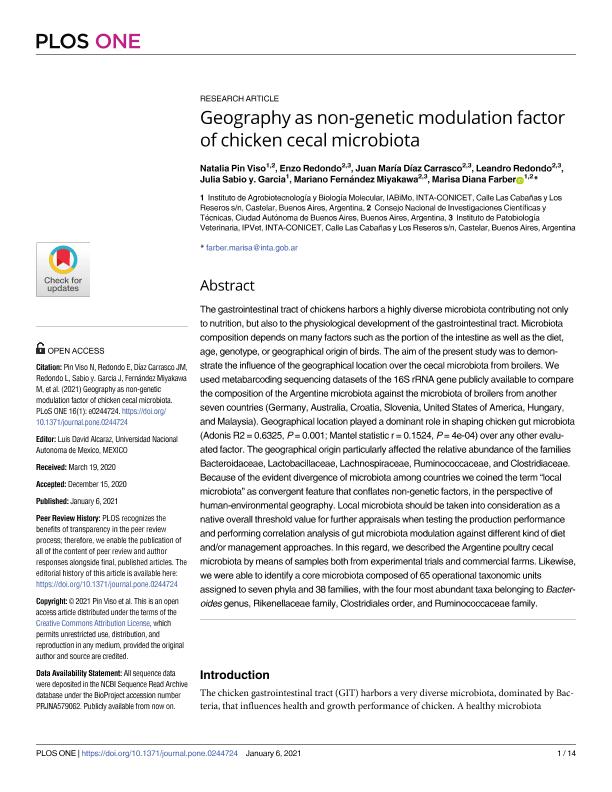Artículo
Geography as non-genetic modulation factor of chicken cecal microbiota
Pin Viso, Natalia Daniela ; Redondo, Enzo Alejandro
; Redondo, Enzo Alejandro ; Díaz Carrasco, Juan María
; Díaz Carrasco, Juan María ; Redondo, Leandro Martin
; Redondo, Leandro Martin ; Sabio y Garcia, Julia Veronica
; Sabio y Garcia, Julia Veronica ; Fernandez Miyakawa, Mariano Enrique
; Fernandez Miyakawa, Mariano Enrique ; Farber, Marisa Diana
; Farber, Marisa Diana
 ; Redondo, Enzo Alejandro
; Redondo, Enzo Alejandro ; Díaz Carrasco, Juan María
; Díaz Carrasco, Juan María ; Redondo, Leandro Martin
; Redondo, Leandro Martin ; Sabio y Garcia, Julia Veronica
; Sabio y Garcia, Julia Veronica ; Fernandez Miyakawa, Mariano Enrique
; Fernandez Miyakawa, Mariano Enrique ; Farber, Marisa Diana
; Farber, Marisa Diana
Fecha de publicación:
01/2021
Editorial:
Public Library of Science
Revista:
Plos One
ISSN:
1932-6203
Idioma:
Inglés
Tipo de recurso:
Artículo publicado
Clasificación temática:
Resumen
The gastrointestinal tract of chickens harbors a highly diverse microbiota contributing not only to nutrition, but also to the physiological development of the gastrointestinal tract. Microbiota composition depends on many factors such as the portion of the intestine as well as the diet, age, genotype, or geographical origin of birds. The aim of the present study was to demonstrate the influence of the geographical location over the cecal microbiota from broilers. We used metabarcoding sequencing datasets of the 16S rRNA gene publicly available to compare the composition of the Argentine microbiota against the microbiota of broilers from another seven countries (Germany, Australia, Croatia, Slovenia, United States of America, Hungary, and Malaysia). Geographical location played a dominant role in shaping chicken gut microbiota (Adonis R2 = 0.6325, P = 0.001; Mantel statistic r = 0.1524, P = 4e-04) over any other evaluated factor. The geographical origin particularly affected the relative abundance of the families Bacteroidaceae, Lactobacillaceae, Lachnospiraceae, Ruminococcaceae, and Clostridiaceae. Because of the evident divergence of microbiota among countries we coined the term “local microbiota” as convergent feature that conflates non-genetic factors, in the perspective of human-environmental geography. Local microbiota should be taken into consideration as a native overall threshold value for further appraisals when testing the production performance and performing correlation analysis of gut microbiota modulation against different kind of diet and/or management approaches. In this regard, we described the Argentine poultry cecal microbiota by means of samples both from experimental trials and commercial farms. Likewise, we were able to identify a core microbiota composed of 65 operational taxonomic units assigned to seven phyla and 38 families, with the four most abundant taxa belonging to Bacteroides genus, Rikenellaceae family, Clostridiales order, and Ruminococcaceae family.
Palabras clave:
GUT MICROBIOTA
,
POULTRY
,
GEOGRAPHICAL LOCATION
Archivos asociados
Licencia
Identificadores
Colecciones
Articulos (IABIMO)
Articulos de INSTITUTO DE AGROBIOTECNOLOGIA Y BIOLOGIA MOLECULAR
Articulos de INSTITUTO DE AGROBIOTECNOLOGIA Y BIOLOGIA MOLECULAR
Articulos (IPVET)
Articulos de INSTITUTO DE PATOBIOLOGIA VETERINARIA
Articulos de INSTITUTO DE PATOBIOLOGIA VETERINARIA
Citación
Pin Viso, Natalia Daniela; Redondo, Enzo Alejandro; Díaz Carrasco, Juan María; Redondo, Leandro Martin; Sabio y Garcia, Julia Veronica; et al.; Geography as non-genetic modulation factor of chicken cecal microbiota; Public Library of Science; Plos One; 16; 1; 1-2021; 1-14
Compartir
Altmétricas



